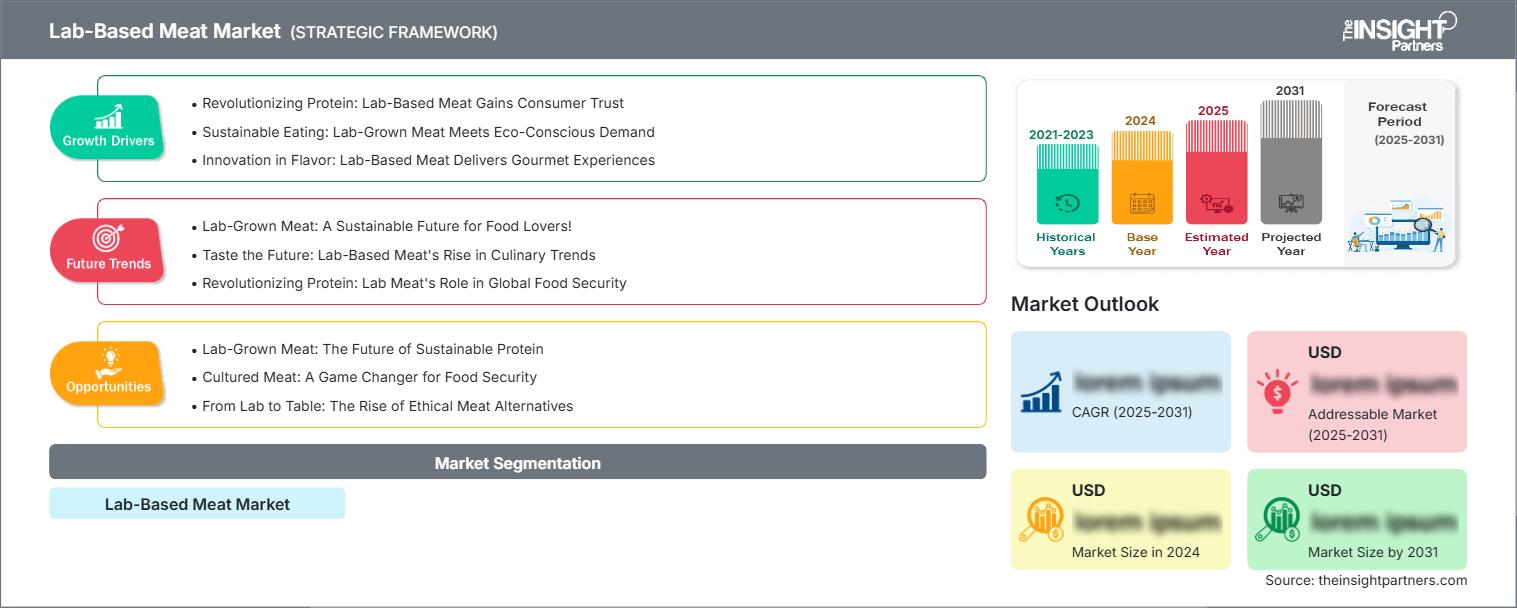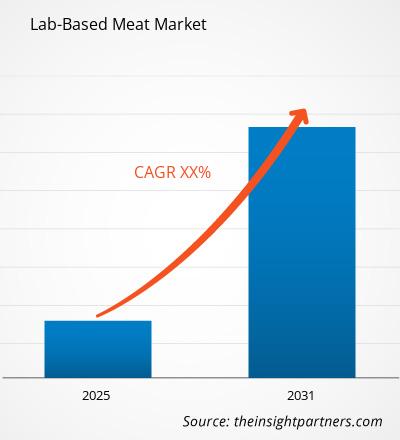INTRODUZIONE AL MERCATO
La carne di laboratorio, nota anche come carne coltivata o carne in vitro, è una forma di carne artificiale ottenuta mediante ingegneria tissutale. È considerata una forma di agricoltura cellulare. Per decenni, la carne animale è stata consumata per soddisfare il fabbisogno nutrizionale dell'organismo, poiché è un'eccellente fonte di acidi grassi omega-3, vitamina B12, proteine e ferro. La carne di laboratorio viene creata in laboratorio/in vitro coltivando cellule muscolari di animali e consentendo loro di espandersi e proliferare in terreni di coltura.
DINAMICHE DI MERCATO
Questo mercato è ancora in fase di sviluppo e i prodotti non sono ancora disponibili in commercio. Tuttavia, si prevede che questo scenario cambierà nel prossimo futuro con l'allentamento delle normative sulla carne di origine animale. Si prevede che il mercato della carne di origine animale registrerà una crescita significativa nei prossimi anni grazie alla crescente preferenza dei consumatori per il consumo di sostituti dei prodotti di origine animale. Le crescenti preoccupazioni ambientali sono uno dei principali motori dello sviluppo della carne di origine animale. L'impatto ambientale della carne di origine animale è significativamente inferiore rispetto a quello dell'allevamento tradizionale. Inoltre, le crescenti preoccupazioni sulla crudeltà sugli animali nella produzione di carne hanno avuto un impatto significativo sulla mentalità dei consumatori riguardo al consumo di prodotti a base di carne. Regioni sviluppate come Europa e Nord America stanno registrando un maggiore consumo di prodotti analoghi della carne, con conseguente forte crescita del mercato della carne di origine animale in queste regioni. La popolazione in continua crescita e la conseguente domanda di cibo saranno un altro fattore chiave per la crescita del mercato. Si prevede che l'attuazione di normative rigorose per i prodotti alimentari adattati naturalmente avrà un'influenza negativa sullo sviluppo della carne di origine animale. Ad esempio, nell'Unione Europea, i nuovi alimenti, come i prodotti a base di carne ottenuti in laboratorio, devono essere sottoposti a un periodo di sperimentazione di circa 18 mesi, durante il quale un'azienda deve dimostrare all'Autorità europea per la sicurezza alimentare (EFSA) che il proprio prodotto è sicuro. Inoltre, i prezzi elevati dei prodotti, l'accettazione da parte dei consumatori e la scarsa conoscenza della coltivazione in vitro della carne stanno ostacolando la crescita del mercato. Tuttavia, con la costante crescita dell'industria di trasformazione alimentare e del settore dell'ingegneria tissutale, ci saranno opportunità per gli operatori del mercato di investire in questo mercato.
Riceverai la personalizzazione gratuita di qualsiasi report, incluse parti di questo report, analisi a livello nazionale, pacchetto dati Excel e potrai usufruire di fantastiche offerte e sconti per start-up e università.
Mercato della carne di laboratorio e geografia (Nord America, Europa, Asia Pacifico e Sud e Centro America)Mercato: approfondimenti strategici

-
Scopri le principali tendenze di mercato di questo rapporto.Questo campione GRATUITO includerà analisi dei dati, che spaziano dalle tendenze di mercato alle stime e alle previsioni.
L'"Analisi del mercato globale della carne di laboratorio fino al 2031" è uno studio specializzato e approfondito del settore alimentare e delle bevande, con particolare attenzione all'analisi delle tendenze del mercato globale. Il rapporto mira a fornire una panoramica del mercato della carne di laboratorio, con una segmentazione dettagliata per origine, destinazione d'uso e area geografica. Si prevede che il mercato globale della carne di laboratorio registrerà una crescita esponenziale durante il periodo di previsione. Il rapporto fornisce statistiche chiave sullo stato di mercato dei principali attori del mercato della carne di laboratorio e offre tendenze e opportunità chiave.
SEGMENTAZIONE DEL MERCATO
Il mercato globale della carne prodotta in laboratorio è segmentato in base all'origine e all'utilizzo finale. In base all'origine, il mercato globale della carne prodotta in laboratorio è segmentato in pollame, manzo, maiale e altri prodotti. In base all'utilizzo finale, il mercato è segmentato in hamburger, nuggets, polpette, salsicce e altri prodotti.
Mercato della carne di laboratorio e geografia (Nord America, Europa, Asia Pacifico e America meridionale e centrale) Approfondimenti regionali di mercato
Le tendenze regionali e i fattori che influenzano il mercato della carne di laboratorio e la sua geografia (Nord America, Europa, Asia-Pacifico e America Meridionale e Centrale) durante il periodo di previsione sono stati ampiamente spiegati dagli analisti di The Insight Partners. Questa sezione analizza anche i segmenti di mercato e la geografia (Nord America, Europa, Asia-Pacifico e America Meridionale e Centrale) del mercato della carne di laboratorio in Nord America, Europa, Asia-Pacifico, Medio Oriente e Africa e America Meridionale e Centrale.
Mercato della carne di laboratorio e geografia (Nord America, Europa, Asia Pacifico e Sud e Centro America) Ambito del rapporto di mercato
| Attributo del report | Dettagli |
|---|---|
| Dimensioni del mercato nel 2024 | XX milioni di dollari USA |
| Dimensioni del mercato entro il 2031 | XX milioni di dollari USA |
| CAGR globale (2025 - 2031) | XX% |
| Dati storici | 2021-2023 |
| Periodo di previsione | 2025-2031 |
| Segmenti coperti | Dal mercato della carne in laboratorio |
| Regioni e paesi coperti |
America del Nord
|
| Leader di mercato e profili aziendali chiave |
|
Mercato della carne di laboratorio e geografia (Nord America, Europa, Asia Pacifico e Sud e Centro America) Densità degli attori del mercato: comprendere il suo impatto sulle dinamiche aziendali
Il mercato della carne di laboratorio e la sua geografia (Nord America, Europa, Asia-Pacifico e America Centrale e Meridionale) sono in rapida crescita, trainati dalla crescente domanda degli utenti finali, dovuta a fattori quali l'evoluzione delle preferenze dei consumatori, i progressi tecnologici e una maggiore consapevolezza dei benefici del prodotto. Con l'aumento della domanda, le aziende stanno ampliando la propria offerta, innovando per soddisfare le esigenze dei consumatori e sfruttando le tendenze emergenti, alimentando ulteriormente la crescita del mercato.

- Ottieni il mercato della carne di laboratorio e la sua geografia (Nord America, Europa, Asia Pacifico e Sud e Centro America). Panoramica dei principali attori del mercato.
QUADRO REGIONALE
Il rapporto fornisce una panoramica dettagliata del settore, includendo informazioni sia qualitative che quantitative. Fornisce una panoramica e una previsione del mercato globale della carne di laboratorio, suddivisa per diversi segmenti. Fornisce inoltre stime sulle dimensioni del mercato e sulle previsioni per il periodo 2023-2031, in relazione a cinque regioni principali: Nord America, Europa, Asia-Pacifico (APAC), Medio Oriente e Africa (MEA) e Sud e Centro America. Il mercato della carne di laboratorio per ciascuna regione viene successivamente suddiviso in sottosegmenti per Paese e segmento. Il rapporto include l'analisi e le previsioni di 18 Paesi a livello globale, insieme alle tendenze attuali e alle opportunità prevalenti nella regione.
Il rapporto analizza i fattori che influenzano il mercato della carne di laboratorio sia dal lato della domanda che da quello dell'offerta e valuta ulteriormente le dinamiche di mercato che incidono sul mercato durante il periodo di previsione, ovvero fattori trainanti, limitazioni, opportunità e tendenze future.
ATTORI DEL MERCATO
I report coprono gli sviluppi chiave nel mercato della carne di laboratorio, come strategie di crescita organica e inorganica. Diverse aziende si stanno concentrando su strategie di crescita organica, come lanci di prodotti, approvazioni di prodotti e altre strategie come brevetti ed eventi. Le attività di crescita inorganica osservate nel mercato sono state acquisizioni, partnership e collaborazioni. Queste attività hanno aperto la strada all'espansione del business e della base clienti degli operatori del mercato. Si prevede che i pagatori del mercato della carne di laboratorio avranno opportunità di crescita redditizie in futuro, grazie alla crescente domanda di carne di laboratorio nel mercato globale. Di seguito è riportato l'elenco di alcune aziende impegnate nel mercato della carne di laboratorio.
Il rapporto include anche i profili delle aziende chiave, insieme alla loro analisi SWOT e alle strategie di mercato nel mercato della carne di laboratorio. Inoltre, il rapporto si concentra sui principali attori del settore, fornendo informazioni quali profili aziendali, componenti e servizi offerti, dati finanziari e sviluppi chiave.
- Carni di Memphis
- Alimenti biotecnologici
- Mangia solo, Inc.
- Aleph Farms Ltd
- Avant Meats Company Limited
- Future Meat Technologies Ltd
- Lab Farm Foods
- Finless Foods Inc.
- Adatto alla carne
- SuperMea
- Analisi storica (2 anni), anno base, previsione (7 anni) con CAGR
- Analisi PEST e SWOT
- Valore/volume delle dimensioni del mercato - Globale, Regionale, Nazionale
- Industria e panorama competitivo
- Set di dati Excel
Report recenti
Testimonianze
Motivo dell'acquisto
- Processo decisionale informato
- Comprensione delle dinamiche di mercato
- Analisi competitiva
- Analisi dei clienti
- Previsioni di mercato
- Mitigazione del rischio
- Pianificazione strategica
- Giustificazione degli investimenti
- Identificazione dei mercati emergenti
- Miglioramento delle strategie di marketing
- Aumento dell'efficienza operativa
- Allineamento alle tendenze normative






















 Ottieni un campione gratuito per - Mercato della carne di laboratorio e geografia (Nord America, Europa, Asia Pacifico e Sud e Centro America)
Ottieni un campione gratuito per - Mercato della carne di laboratorio e geografia (Nord America, Europa, Asia Pacifico e Sud e Centro America)